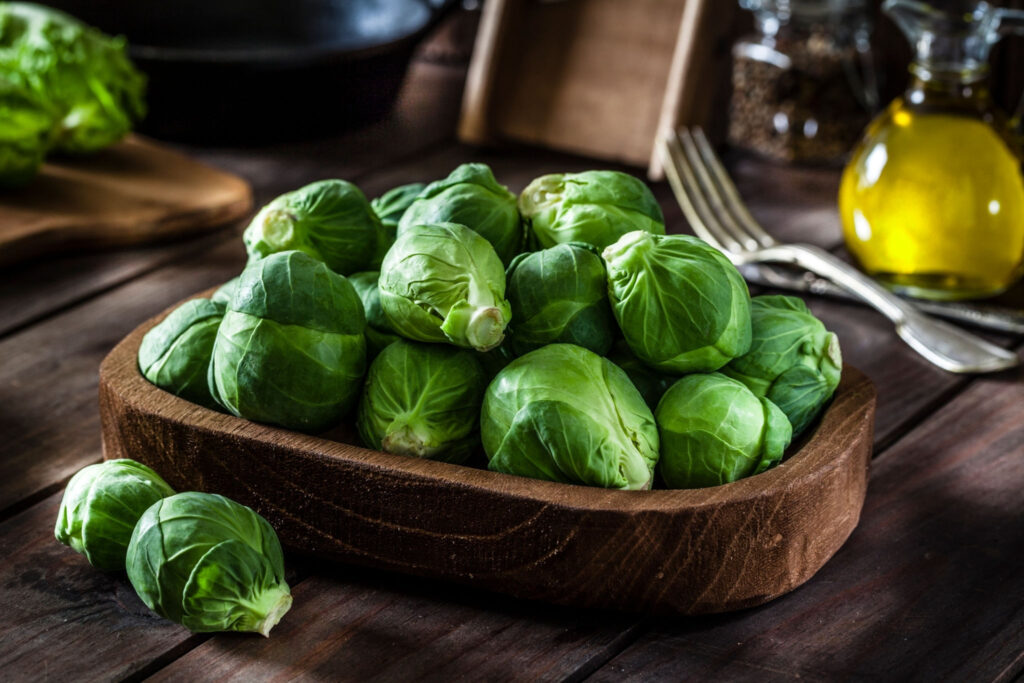Brussel Sprouts may not have been a huge hit when you were a kid, but these are very nutritious vegetables that we learn to love (or have always loved) today. What’s great about these vegetables is that, now that we’re older, we can learn how to plant them in the comforts of our homes!
These vegetables resemble baby cabbages and are lined up in neat rows on tall stalks, growing naturally vertically without the need for support. This is why they are great to plant on space-saving containers.
But wait! What if you have limited space or no backyard? Can you grow Brussel Sprouts indoors instead?
Fortunately, it IS possible, though you’ll need to make sure you tend to it properly and provide extra care, So, read on to find out how to grow Brussel Sprouts indoors!

Can You Grow Brussel Sprouts Indoors?
As I mentioned above, YES, you can grow Brussel Sprouts indoors.
In fact, you do need to grow Brussel Sprouts indoors before transplanting them outside. However, you can grow them in containers without having to move them outside.
Of course, caring for your plants will be slightly different compared to growing them outdoors. You’ll need to place it in a location that gets at least 6-8 hours of sunlight daily, or if you invest in strong grow lights, among meeting other nutrient requirements.
It’s also best for you to invest in the right Brussel Sprout variety made for container gardening. You’ll want to select dwarf or semi-dwarf varieties, as the typical Brussel Sprout plant will require a lot of space for sprouting. These varieties won’t grow as tall compared to other types and will less likely need support systems to stop them from toppling the pot over.
Here are the varieties you should get:
- Jade Cross is a hybrid that can produce yields of flavorful sprouts, growing up to 28 inches tall. They are more compact and less vulnerable to wind damage
- Catskill is a variety that can produce large yields of large sprouts, measuring up to 2 inches long. They have a strong stalk and are ideal to freeze
- Long Island Improved is a semi-dwarf plant variety growing with its eaves closely spaced together, with the sprouts growing on sport and self-supporting stems
With that said, take note that while you can grow them indoors, it’s most likely that you won’t have that big of a harvest compared to planting the Brussel Sprout plants outside. The only time I recommend planting this vegetable indoors is if you have no space or optimal planting conditions outdoors, or if you live in an area with a cold climate and plan to use indoor grow lights.
Tips to Grow Brussel Sprouts Indoors
Now that you know that you can grow Brussel Sprouts indoors, how can you start doing so? Fortunately, it’s similar to gardening in pots or containers outdoors, but they require a place where they get direct light sources, whether from the sun or grow lights. Here are steps and tips you can follow:
1. Select the Right Pot
For starters, you’ll need the right-sized pot. You can opt for a standard 5-7 gallon-sized planter that’s at least 12 inches deep with a diameter of 12-14 inches. You can grow one plant of Brussel Sprouts in this container.
If you plan to grow more than one plant together, invest in a 15-gallon pot or one that has a diameter of at least 18 inches. I also recommend that you invest in a clay pot, which is best for frost-free areas as these would remain cool and drain well while providing great air circulation.
2. Planting Brussel Sprouts
Brussel Sprouts are cool-season crops that taste great when maturing in cooler air temperatures, which is why it’s best to start planting them during the early spring if you live in a region with cool summers. Or, you can begin planting them mid to late summer if you live in moderate climates. Doing so will allow you to get a winter or spring harvest, with the sprouts tasting better.
When you begin growing Brussel Sprouts from seeds, start them directly in the container indoors. Make sure that you maintain the soil temperature, which should range between 45-85 degrees F.
Sow the seeds half an inch deep, waiting for a few days for the baby plants to sprout, taking between 5-20 days. After you see them grow its first pair of leaves, thin them, saving only the healthiest one.
3. Growing Brussel Sprouts in Pots
While it would usually be time to transplant them after they have their first pair of leaves, you’ll be planting them indoors. Be sure to place them in a location that’s sunny with great air circulation for better growth. Don’t place them in windy sites, as this can have them fall over because they have thin bases, making them unstable plants, affecting their productivity.
Keep the soil moist, filling the pot with a quality potting mix that drains well, is light and deep, rich with hummus and a clay texture. The soil’s pH levels need to be neutral, and you may want to add well-rotted manure as you plant, which adds more fertilizer and nutrition to your soil and plants.
Be sure to water the plants regularly to prevent the soil and plants from drying, but do NOT overwater. Once they grow tall enough, it’s time to begin staking them to keep them from growing in their containers upright, which can have them fall over.
Wrapping It Up
When it comes to growing Brussel Sprouts indoors, it’s possible but requires more space and nutrition compared to other plants that can grow inside. With the right knowledge and expertise, you can start growing Brussel Sprouts to consume anytime!
Hopefully, this article answered your question, “can you grow Brussel Sprouts indoors?” Now that you know the answer and want to plant this vegetable, prepare ahead so you can harvest them successfully in time!